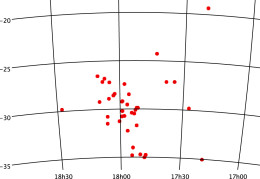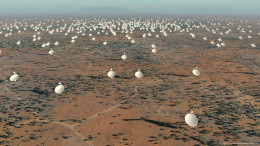The modern search for extraterrestrial intelligence, known as SETI, began at radio observatories more than 50 years ago. Now scientists at the Murchison Widefield Array (MWA) in Western Australia have launched a new SETI endeavor — the first to look for signals in the low-radio-frequency regime.
New Approach
Because radio waves are such an important part of human communication, many SETI experiments search for signals from alien civilizations in radio bands — typically in the 1.4–1.7 GHz frequency range. But recently, new radio observatories are being developed in the lower-frequency range, including the MWA at 80–300 MHz.
The primary goals of the MWA are to detect neutral atomic hydrogen from the Epoch of Reionization and to study the Sun, heliosphere, and Earth’s ionosphere. In July of 2014 it was undertaking a spectral line survey of the galactic plane, when a team of scientists led by Steven Tingay (ICRAR, Curtin University, Australia; National Institute for Astrophysics, Italy) realized that this data could also be used for SETI purposes.
The Hunt for Communication

Distribution of the 38 known exoplanet systems in the field of view of this study. [Tingay et al. 2016]
Tingay and collaborators examined observations from the MWA that consisted of spectra in the 103–133 MHz range for each part of the sky in a 400-square-degree field of view. The authors compared this field to the Kepler catalog, identifying 45 planets in 38 known planetary systems within the field. They then examined the MWA spectra at the locations of each planetary system, searching for narrowband radio signals coming from the systems.

Sample spectrum from one of the closest stars in the MWA field. No signals from alien civilizations are evident here. [Adapted from Tingay et al. 2016]
No Civilizations Yet
No such signals were found, and Tingay and collaborators used their observations to set upper limits on the power of any isotropic emission coming from each system. As an example, they found that no signals in the 103–133 MHz range are being broadcast from the planets around GJ 667C — which is 22 light-years away — with a power greater than ~1013 W.
This limit, however, is still 1000 times more powerful than the most powerful transmission ever deliberately broadcast into space by humans: a message sent from the Arecibo observatory with an equivalent isotropic transmission of ~1010 W. This means that these observations from the MWA may not be sensitive enough to detect messages from hypothetical alien civilizations.
Proof of Future Capabilities

Artist’s impression of the Square Kilometer Array, a future radio observatory. [SKA/Swinburne Astronomy Productions]
Longer observing time still could search even deeper, and future arrays observing in similar frequency ranges, like the Square Kilometer Array, will be even more sensitive. This study demonstrates the utility of such arrays for conducting SETI experiments in this new low-frequency band.
Citation
S. J. Tingay et al 2016 ApJ 827 L22. doi:10.3847/2041-8205/827/2/L22


1 Comment
Pingback: Murchison Widefield Array Report - newsletter